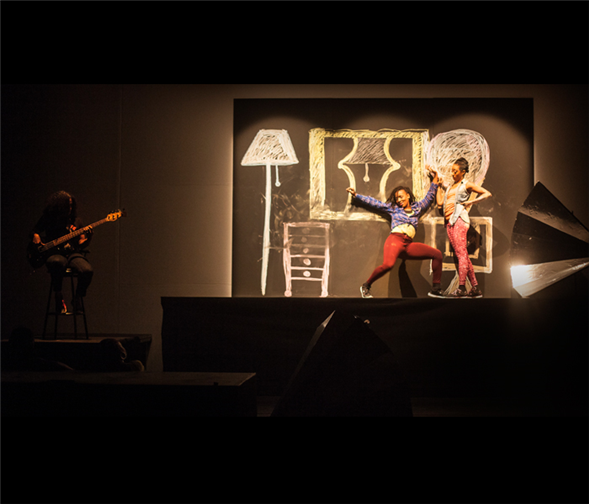Translate Page

Camille A. Brown's new work celebrates the entire scope of a black woman's life
---
On a sweltering August day, Camille A. Brown sits in front of her dancers in a basement studio. Once she nods, Fana Fraser and Catherine Foster start a simple phrase, one swooping into a cross jump, the other darting backward. After almost every four counts, Brown pauses the dancers, asking for an adjustment, using just a few words to create massive changes: "Can we take the rhythm out?" or, "This time, do it like you're marking it…not full out." The dancers' faces flicker with recognition, and after a few moments they start over.
Soon, Brown interrupts them again. Then again. All told, the tweaks continue for two hours, each one edging the troupe closer toward a dance theatre piece that offers a trifecta of riches: viscerally provocative dance, compelling narrative, and resonant humanity.
Ultimately, this process has resulted in Camille A. Brown & Dancers' full-length presentation of BLACK GIRL: Linguistic Play, premiering for NYC audiences at The Joyce Theater from September 22 to 27. As a choreographer known for her complex work, the theatrical nature of BLACK GIRL — which follows black women at different stages of life — illustrates Brown's evolution toward more narrative material. (She eventually hopes to choreograph for musical theatre.) But for all its familiarity, the piece also asks surprising questions about race.
Those questions began forming while Brown was on tour, showing small sections of the work as it developed. "During the talkbacks, black women would ask me, 'Are you going to talk about issues specific to black females?'" she recalls. "I wanted to, but I also didn't want to just do it because it was expected. So I asked myself, 'What do I want to add to that narrative? If we're going to talk about black girls in this climate, I'm going to do so in a different way.' I realized in the media, I don't see young black girls in childhood together in stories. I started to remember the things I used to do in terms of Double Dutch and gesture. It was specific and multi-dimensional, versus a one-dimensional stereotype. So I decided, yes, we need to have the conversation of what's wrong, but we also need to have the conversation about who we are, our joy, and what is it to simply be a black girl."
To probe this idea, Brown altered her approach in the studio. While she usually seeks occasional feedback from her dancers, she now required a larger amount of collaboration. (All of the performers in this piece, including Brown herself, are black women.) "I had to say, 'Put yourself in this,'" she says. "This isn't just my story as a black girl. This is also your story as a black girl.'"
The dancers' everyday gestures served as one focal point for their individual contributions. As Brown explains, "I asked, 'How does putting your hand on your hip or the way you walk affect the story?' Because we're working this way, it should look like they choreographed it themselves – it should feel like home for them."
{Image1}
And though Brown's goal wasn't necessarily to discuss racial tensions, showings of the work-in-process nevertheless provoked audience discussions about stereotypes and bias. "During one talkback, after performing one of the sections, a woman noted that after seeing me on an elevated podium with chalk, that suggested to her that I was in jail," remembers Brown. "It was so interesting: I hadn't even done anything. In my mind, I had chalk like a little girl would use on a sidewalk. But to her, it was a prison or a slave on a podium. Would she have the same idea if it had been a white woman? People don't realize they've separated themselves until you remind them. It's important, and the talkbacks are a safe space for that." To that end, talkbacks moderated by a carefully chosen panel are planned for the Joyce's run as well.
Brown adds that along with the culturally specific themes, she and her dancers have also noticed more universal concepts in the piece.
To wit: As the dancers practice the finale, which features all six performers, one quietly repeats gestures alone in the back while another dives into a tap-based solo. The overlap reminds Yusha-Marie Sorzano of life's constant motion.
"It's like how people pass each other in life," she says. "They could link up, or not. They might keep going or not. They might be separate or meet. You're in sync for a moment and then not -- maybe never again. It's like the Buddhist idea: With every moment you have 3000 choices. There's that potential to always keep it fresh."
Brown smiles in agreement as the idea echoes in the room.
---
TDF Members: There are currently discounted tickets available to this show. Click here to see all the shows being offered to members.
Lauren Kay frequently covers dance for TDF Stages
Photos by John Werner. Top Photo: A scene from BLACK GIRL.